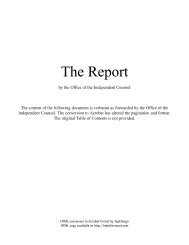THE ENTRENCHING OF INCUMBENCY_ ... - Lou Frey Institute
THE ENTRENCHING OF INCUMBENCY_ ... - Lou Frey Institute
THE ENTRENCHING OF INCUMBENCY_ ... - Lou Frey Institute
Create successful ePaper yourself
Turn your PDF publications into a flip-book with our unique Google optimized e-Paper software.
<strong>THE</strong> <strong>ENTRENCHING</strong> <strong>OF</strong> <strong>INCUMBENCY</strong>: REELECTIONS IN <strong>THE</strong> U.S. HOUSE <strong>OF</strong> REPRESENTATIVES, 1790-1994<br />
The history of congressional turnover readily breaks into four parts: (1) the Republican Era of Social Deference and<br />
Public Service, 1787-1828; (2) the Era of Jacksonian Democracy, 1829-95; (3) the Era of Safe Seats, 1896-1957; and<br />
(4) the Era of Entrenched Incumbency 1958-present. Each of the four periods represents a distinct set of circumstances<br />
that shaped elections and reelections for the U.S. House of Representatives.<br />
The Republican Era of Social Deference and Public Service<br />
James Madison was immersed in political theory during the winter of 1786-87. He read voraciously prior to the<br />
Constitutional Convention that met in Philadelphia the following spring. Although the convention was billed as a<br />
means to improve the existing Articles of Confederation, Madison and some of his allies had far more ambitious plans<br />
for the gathering. They were going to construct a new political system from the ground up, that would usher in "a new<br />
order of the ages" (Novus Ordo Seclorum). Madison and his allies understood that the success of the great American<br />
republican experiment rested on their ability to properly structure the new government. His political consultants<br />
included the great philosophers of antiquity, generations of English republican theorists, and the leading figures of the<br />
European Enlightenment. Among the subjects Madison's reading encouraged him to consider, when he contemplated<br />
the proper design for a national legislature, was "rotation in offices."<br />
The principle that new representatives should regularly be circulated through the political system was an integral part<br />
of republican political theory. Aristotle (Politics, IV, Sec. 2: 2091) wrote approvingly of how office rotation was<br />
practiced in ancient Greece, where citizens were retired from public office to live under the laws they had made, and<br />
replaced by a new group of citizens. Livy recorded that offices were also rotated in the Roman Republic. Sixteenthcentury<br />
Italian humanist writers advocated republican political structures, including mandatory rotation of offices, that<br />
encouraged rulers to exercise virtue over self-interests. From the Italian humanists the Englishman James Harrington<br />
adopted many of his political ideas. Like James Madison much later, Harrington aspired to design and build a republic.<br />
The result was his The Republic of Oceana ([1656] 1977), a constitutional blueprint that Harrington tried,<br />
unsuccessfully, to sell to Oliver Cromwell during the English Civil War. For Harrington, rotation of offices was<br />
absolutely essential to the well-being of a republic. A legislator returning to the body of the people was analogous to a<br />
blood cell returning to the lungs to be enriched with fresh oxygen (Pocock 1975: 393-95). Generations of English<br />
republican thinkers adopted Harrington's ideas on rotation (Robbins 1968). John Trenchard and Thomas Gordon, who<br />
were especially influential in America, wrote on the subject in Cato's Letters ([1755] 1995: Nos. 43, 61; Bailyn 1967:<br />
35-36) and warned that long tenure in office frequently led to aristocracy.<br />
http://www.cato.org/pubs/journal/cj14n3-2.html[9/13/2011 1:45:53 PM]



